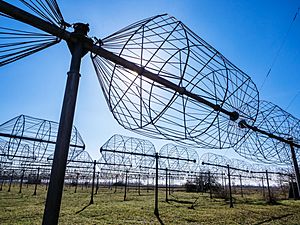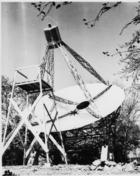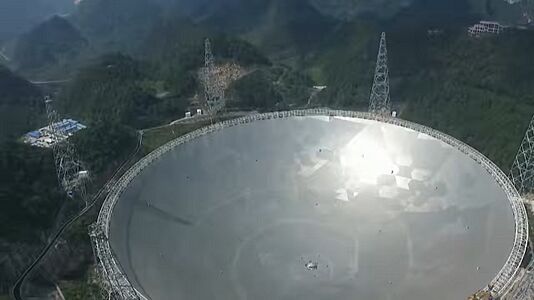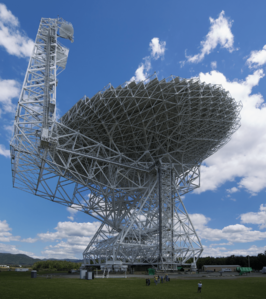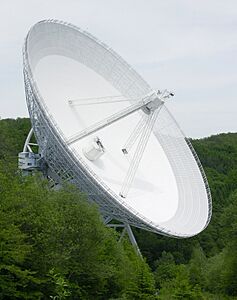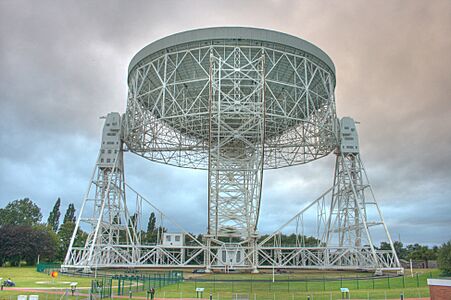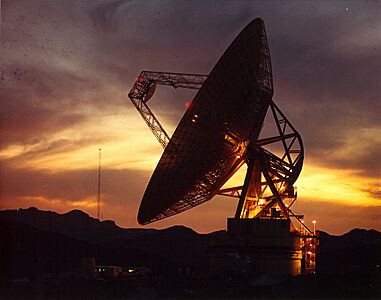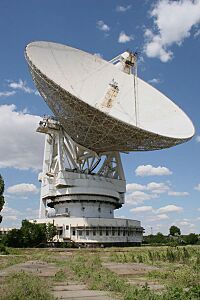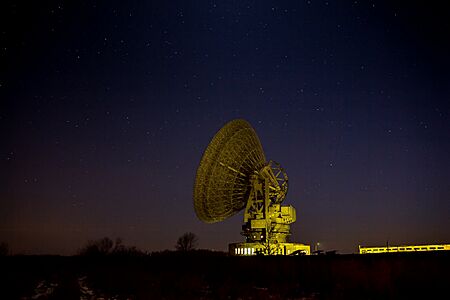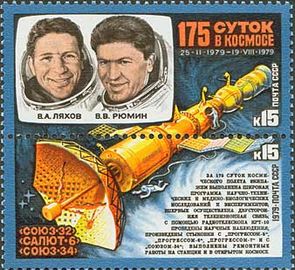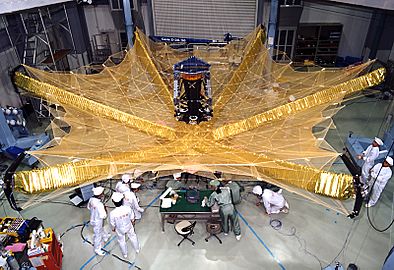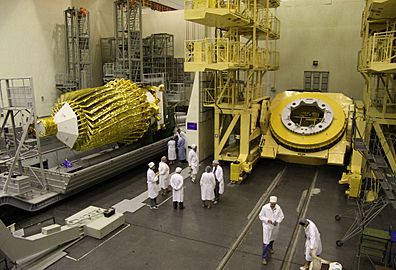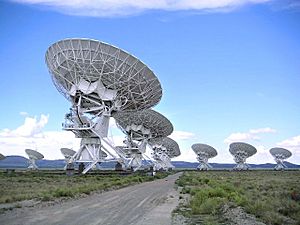Radio telescope facts for kids
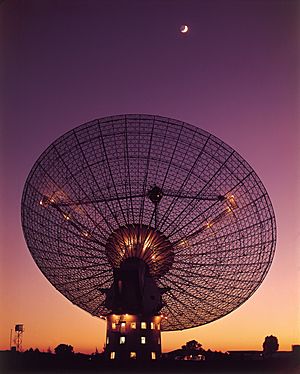
A radio telescope is a special kind of antenna and receiver. It helps scientists find radio waves coming from space. These waves come from things like stars, planets, and galaxies. Radio telescopes are key tools in radio astronomy. This field studies the radio part of the electromagnetic spectrum. Think of it like how regular optical telescopes study visible light. A cool thing about radio telescopes is that they work day and night.
Space objects are very far away. This means the radio waves they send are super weak. So, radio telescopes need huge antennas to collect enough energy. They also need very sensitive equipment to hear these faint signals. Most radio telescopes look like big satellite dishes. They can work alone or be linked together. Radio observatories are often built far from cities. This helps avoid electromagnetic interference from phones, TVs, and cars.
The first time radio waves from space were found was in 1932. Engineer Karl Guthe Jansky discovered them. He was working at Bell Telephone Laboratories in New Jersey. He used an antenna built to study radio noise. The first radio telescope made just for astronomy was built in 1937. It was a 9-meter dish. Grote Reber, a radio amateur, built it in his backyard. His sky survey is seen as the start of radio astronomy.
Contents
Discovering Radio Waves from Space
Jansky's First Antenna
In 1932, Karl Guthe Jansky built the first antenna to find radio waves from space. He was an engineer at Bell Labs. His job was to find out what caused static that messed with phone calls. Jansky's antenna was made of dipoles and reflectors. It picked up short wave radio signals at 20.5 MHz. This antenna was about 30 meters wide and 6 meters tall. It could spin around, so people called it "Jansky's merry-go-round."
A small shed next to the antenna held a recording system. Jansky recorded signals for months. He found three types of static. Two were from thunderstorms. The third was a faint, steady hiss. This hiss repeated every 23 hours and 56 minutes. This is the length of an astronomical sidereal day. It's how long it takes a "fixed" object in the sky to return to the same spot. Jansky thought the hiss came from outside our Solar System. He compared his findings with star maps. He realized the radio waves came from the Milky Way Galaxy. They were strongest from the center of the galaxy, in the constellation of Sagittarius.
Reber's Backyard Telescope
An amateur radio operator named Grote Reber was a pioneer in radio astronomy. In 1937, he built the first dish-shaped radio telescope. It was 9 meters wide. He built it in his backyard in Illinois. Reber repeated Jansky's work. He also found the Milky Way was the first radio source from outside Earth. Then, he made the first map of the sky using very high radio frequencies. He found other radio sources too.
During World War II, radar technology grew fast. After the war, this technology helped radio astronomy. Universities and research centers started building large radio telescopes. This made radio astronomy a big part of astronomy.
Different Kinds of Radio Telescopes
The radio spectrum is a very wide range of frequencies. Because of this, radio telescopes come in many shapes and sizes. For very long radio waves (10 to 100 MHz), telescopes often look like large TV antennas. Or they might be big, fixed reflectors with parts that can move. Since these waves are so long, the reflector surfaces can be made of simple wire mesh, like chicken wire.
For shorter radio waves, dish antennas are most common. How clear an image a dish can make depends on its size compared to the wavelength it observes. This means radio telescopes need to be very large for good images. Telescopes that work with wavelengths from 3 meters to 30 cm (100 MHz to 1 GHz) are usually over 100 meters wide. Smaller dishes, from 3 to 90 meters wide, work with wavelengths shorter than 30 cm (above 1 GHz).
Important Frequencies for Astronomy
More and more, people use radio frequencies for communication. This makes it harder for astronomers to observe space. Scientists work to protect certain frequencies for radio astronomy.
Some important radio frequencies used by telescopes include:
- Every frequency in the United States National Radio Quiet Zone.
- Channel 37: 608 to 614 MHz.
- The "Hydrogen line" (21 centimeter line): 1,420.40575177 MHz. Many telescopes use this, including The Big Ear when it found the Wow! signal.
- 1,406 MHz and 430 MHz.
- The Waterhole: 1,420 to 1,666 MHz.
- The Arecibo Observatory had receivers that covered 1–10 GHz.
- The Wilkinson Microwave Anisotropy Probe mapped the cosmic microwave background radiation. It used 5 frequency bands: 23 GHz, 33 GHz, 41 GHz, 61 GHz, and 94 GHz.
Giant Dish Telescopes

The world's largest single-dish radio telescope is the Five-hundred-meter Aperture Spherical Telescope (FAST). China finished building it in 2016. This 500-meter wide dish is as big as 30 football fields. It's built into a natural bowl-shaped area in Guizhou province. The dish itself cannot move. Instead, the feed antenna hangs above the dish on cables.
The dish is made of 4,450 movable panels. A computer controls these panels. By changing the dish's shape and moving the feed antenna, the telescope can look at different parts of the sky. It can see up to 40° from directly overhead. Even though the dish is 500 meters wide, only a 300-meter circle is used at one time. Construction started in 2007 and finished in July 2016. The telescope began working on September 25, 2016.
The Arecibo radio telescope in Arecibo, Puerto Rico, was the world's second largest. Sadly, it collapsed on December 1, 2020. Arecibo was special because it could also send out radio waves to map objects near Earth. Most other telescopes only receive signals. Like FAST, Arecibo was a fixed dish. Its 305-meter dish was also built into a natural depression. It could look at parts of the sky within about 20° of directly overhead. This used a 270-meter part of the dish.
The biggest radio telescope of any kind is the RATAN-600 in Russia. It has a 576-meter circle of rectangular radio reflectors. Each reflector can point to a central receiver.
The telescopes mentioned above cannot fully "steer." They can only look at parts of the sky near directly overhead. They cannot receive signals from objects near the horizon. The largest fully steerable dish radio telescope is the 100-meter Green Bank Telescope. It is in West Virginia, United States, and was built in 2000.
Europe's largest fully steerable radio telescope is the Effelsberg 100-m Radio Telescope. It is near Bonn, Germany. It was the world's largest fully steerable telescope for 30 years. This was until the Green Bank antenna was built. The third-largest fully steerable radio telescope is the 76-meter Lovell Telescope. It is in England and was finished in 1957. There are also six 70-meter dishes. Three are Russian RT-70 telescopes. Three are part of the NASA Deep Space Network. The Qitai Radio Telescope, planned to be 110 meters wide, is expected to be the world's largest fully steerable single-dish telescope when finished in 2028.
Most radio telescopes are about 25 meters wide. Many observatories around the world use telescopes of this size.
Pictures of Big Dishes
-
The 100 meter Green Bank Telescope, US. It is the largest fully steerable radio telescope dish (2002).
-
The 70 meter DSS 14 "Mars" antenna at Goldstone Deep Space Communications Complex, US (1958).
Radio Telescopes in Space
Since 1965, three radio telescopes have been launched into space. The first, KRT-10, was attached to the Salyut 6 space station in 1979. In 1997, Japan launched the second, HALCA. The last one was sent by Russia in 2011, called Spektr-R.
- Space Radio Telescopes
How Radio Interferometry Works
A big step forward happened in 1946. Scientists started using a method called astronomical interferometry. This means combining signals from many antennas. This makes them act like one giant antenna. This helps them see much clearer images.
Radio interferometers usually have many dish antennas. They can also have arrays of one-dimensional antennas. Or they might use two-dimensional arrays of simple dipoles. All the telescopes in the array are spread out. They are usually connected by cables or optical fibers. Newer methods let telescopes record signals separately. Then, these recordings are combined later at a central place. This is called Very Long Baseline Interferometry (VLBI).
Interferometry collects more signal. But its main goal is to greatly improve how clear the images are. This is done through a process called aperture synthesis. It works by mixing the signal waves from different telescopes. Waves that match up in their phase add to each other. Waves that are opposite cancel each other out. This creates a combined telescope. It has the same clarity as a single antenna. That single antenna would be as wide as the distance between the farthest telescopes in the array.

To get a really good image, you need many different distances between telescopes. The distance between any two telescopes, as seen from the radio source, is called a baseline. For example, the Very Large Array (VLA) in New Mexico has 27 telescopes. This creates 351 different baselines at once. It can see details as small as 0.2 arc seconds at 3 cm wavelengths.
Martin Ryle's group in Cambridge won a Nobel Prize for their work on interferometry. The Lloyd's mirror interferometer was also developed in 1946. This was done by Joseph Pawsey's group in Australia. In the early 1950s, the Cambridge Interferometer mapped the radio sky. This led to the famous 2C and 3C surveys.
A large connected radio telescope array is the Giant Metrewave Radio Telescope. It is located in Pune, India. The largest array, the Low-Frequency Array (LOFAR), was finished in 2012. It is in western Europe. It has about 81,000 small antennas. These are spread across 48 stations over hundreds of kilometers. It works with wavelengths between 1.25 and 30 m. VLBI systems use antennas thousands of miles apart. Radio interferometers have also made detailed images of the Cosmic Microwave Background. An example is the CBI interferometer in 2004.
The world's largest physically connected telescope is the Square Kilometre Array (SKA). It began its first observations in 2024.
What Radio Telescopes Observe
Many space objects can be seen not just in visible light. They also send out radiation at radio wavelengths. Radio telescopes can observe energetic objects like pulsars and quasars. They can also "image" most other space objects. This includes galaxies, nebulae, and even radio signals from planets.
See also
 In Spanish: Radiotelescopio para niños
In Spanish: Radiotelescopio para niños
- Aperture synthesis
- Astropulse – a project to search for black holes, pulsars, and alien signals
- Ground station
- List of astronomical observatories
- List of radio telescopes
- List of telescope types
- Search for extraterrestrial intelligence
- Telescope
- Radar telescope


